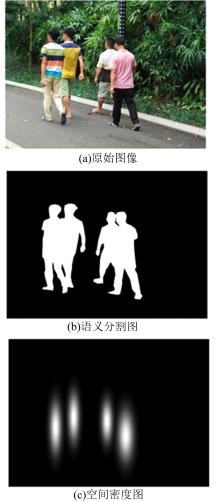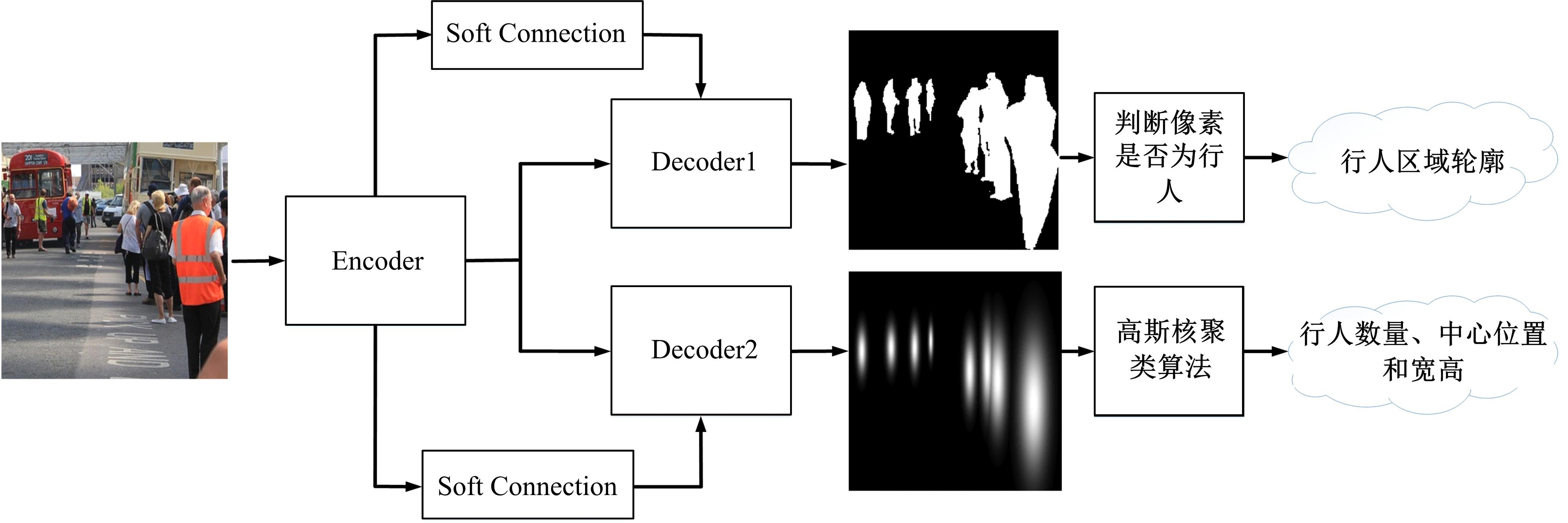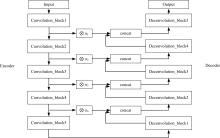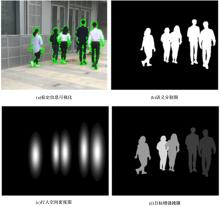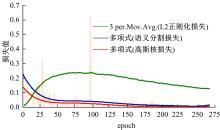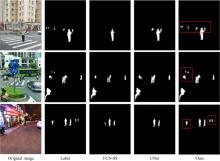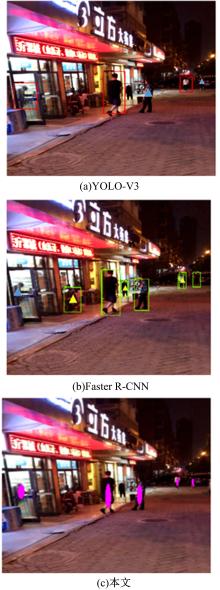Journal of Jilin University(Engineering and Technology Edition) ›› 2022, Vol. 52 ›› Issue (4): 925-933.doi: 10.13229/j.cnki.jdxbgxb20200912
Pedestrian segmentation and detection in multi-scene based on G-UNet
Xue-yun CHEN( ),Xue-yu BEI,Qu YAO,Xin JIN
),Xue-yu BEI,Qu YAO,Xin JIN
- School of Electrical Engineering,Guangxi University,Nanning 530004,China
CLC Number:
- TP391.41
| 1 | Saeidi M, Ahmadi A. Deep learning based on CNN for pedestrian detection: an overview and analysis[C]∥The 9th International Symposium on Telecommunications (IST), Tehran, Iran, 2018: 108-112. |
| 2 | Dalal N, Triggs B. Histograms of oriented gradients for human detection[C]∥IEEE Computer Society Conference on Computer Vision and Pattern Recognition,San Diego, USA, 2005 . |
| 3 | Girshick R, Donahue J, Darrell T, et al. Rich feature hierarchies for accurate object detection and semantic segmentation[C]∥IEEE Conference on Computer Vision and Pattern Recognition, Columbus, USA, 2014. |
| 4 | Girshick R. Fast R-CNN[C]∥IEEE International Conference on Computer Vision (ICCV), Santiago, Chile, 2015. |
| 5 | Ren S, He K, Girshick R, et al. Faster R-CNN: towards real-time object detection with region proposal networks[J]. IEEE Transactions on Pattern Analysis & Machine Intelligence, 2017, 39(6): 1137-1149. |
| 6 | Redmon J, Divvala S, Girshick R, et al. You only look once: unified, real-time object detection[C]∥IEEE Conference on Computer Vision and Pattern Recognition (CVPR), Las Vegas, NV, USA, 2016. |
| 7 | Redmon J, Farhadi A. YOLO9000: Better, faster, stronger[C]∥IEEE Conference on Computer Vision and Pattern Recognition (CVPR),Honolulu,USA, 2017: 6517-6525. |
| 8 | Redmon J, Farhadi A. YOLOv3: An Incremental Improvement[EB/OL].[2018-02-08].. |
| 9 | Tayara H, Kim G S. Vehicle detection and counting in high-resolution aerial images using convolutional regression neural network[J]. IEEE Access, 2017, 6: 2220-2230. |
| 10 | Chen X Y, Lin J Y, Xiang S M, et al. Detecting maneuvering target accurately based on a two-phase approach from remote sensing imagery[J]. IEEE Geoence and Remote Sensing Letters, 2020, 17(5): 849-853. |
| 11 | 罗会兰, 张云. 基于深度网络的图像语义分割综述[J].电子学报, 2019, 47(10): 2211-2220. |
| Luo Hui-lan, Zhang Yun. A survey of image semantic segmentation based on deep network[J]. Acta Electronica Sinica, 2019, 47(10): 2211-2220. | |
| 12 | Shelhamer E, Long J, Darrell T. Fully convolutional networks for semantic segmentation[J]. IEEE Computer Society, 2017, 39(4): 640-651. |
| 13 | Zhao H, Shi J, Qi X, et al. Pyramid scene parsing network[C]∥IEEE Conference on Computer Vision and Pattern Recognition (CVPR), Honolulu, USA, 2017: 6230-6239. |
| 14 | Ronneberger O, Fischer P, Brox T. U-net: convolutional networks for biomedical image segmentation[J]. Computer Vision and Pattern Recognition,2015, 9351: 234-241. |
| 15 | Chen L C, Papandreou G, Schroff F, et al. Rethinking atrous convolution for semantic image segmentation[DB/OL].[2017-02-05].. |
| [1] | Ming LIU,Yu-hang YANG,Song-lin ZOU,Zhi-cheng XIAO,Yong-gang ZHANG. Application of enhanced edge detection image algorithm in multi-book recognition [J]. Journal of Jilin University(Engineering and Technology Edition), 2022, 52(4): 891-896. |
| [2] | Xiao-hui WEI,Yan-wei MIAO,Xing-wang WANG. Rhombus sketch: adaptive and more accurate sketch for streaming data [J]. Journal of Jilin University(Engineering and Technology Edition), 2022, 52(4): 874-884. |
| [3] | Shi-min FANG. Multiple source data selective integration algorithm based on frequent pattern tree [J]. Journal of Jilin University(Engineering and Technology Edition), 2022, 52(4): 885-890. |
| [4] | Da-xiang LI,Meng-si CHEN,Ying LIU. Spontaneous micro-expression recognition based on STA-LSTM [J]. Journal of Jilin University(Engineering and Technology Edition), 2022, 52(4): 897-909. |
| [5] | Xue-zhi WANG,Qing-liang LI,Wen-hui LI. Spatio⁃temporal model of soil moisture prediction integrated with transfer learning [J]. Journal of Jilin University(Engineering and Technology Edition), 2022, 52(3): 675-683. |
| [6] | Su-ming KANG,Ye-e ZHANG. Hadoop⁃based local timing link prediction algorithm across social networks [J]. Journal of Jilin University(Engineering and Technology Edition), 2022, 52(3): 626-632. |
| [7] | Xue WANG,Zhan-shan LI,Ying-da LYU. Medical image segmentation based on multi⁃scale context⁃aware and semantic adaptor [J]. Journal of Jilin University(Engineering and Technology Edition), 2022, 52(3): 640-647. |
| [8] | Ji-hong OUYANG,Ze-qi GUO,Si-guang LIU. Dual⁃branch hybrid attention decision net for diabetic retinopathy classification [J]. Journal of Jilin University(Engineering and Technology Edition), 2022, 52(3): 648-656. |
| [9] | Lin MAO,Feng-zhi REN,Da-wei YANG,Ru-bo ZHANG. Two⁃way feature pyramid network for panoptic segmentation [J]. Journal of Jilin University(Engineering and Technology Edition), 2022, 52(3): 657-665. |
| [10] | You QU,Wen-hui LI. Single-stage rotated object detection network based on anchor transformation [J]. Journal of Jilin University(Engineering and Technology Edition), 2022, 52(1): 162-173. |
| [11] | Hong-wei ZHAO,Dong-sheng HUO,Jie WANG,Xiao-ning LI. Image classification of insect pests based on saliency detection [J]. Journal of Jilin University(Engineering and Technology Edition), 2021, 51(6): 2174-2181. |
| [12] | Zhou-zhou LIU,Qian-yun ZHANG,Xin-hua MA,Han PENG. Compressed sensing signal reconstruction based on optimized discrete differential evolution algorithm [J]. Journal of Jilin University(Engineering and Technology Edition), 2021, 51(6): 2246-2252. |
| [13] | Sheng-sheng WANG,Jing-yu CHEN,Yi-nan LU. COVID⁃19 chest CT image segmentation based on federated learning and blockchain [J]. Journal of Jilin University(Engineering and Technology Edition), 2021, 51(6): 2164-2173. |
| [14] | Dong-ming SUN,Liang HU,Yong-heng XING,Feng WANG. Text fusion based internet of things service recommendation for trigger⁃action programming pattern [J]. Journal of Jilin University(Engineering and Technology Edition), 2021, 51(6): 2182-2189. |
| [15] | Jun-cong LIN,Jun LEI,Meng CHEN,Shi-hui GUO,Xing GAO,Ming-hong LIAO. Real⁃time camera planning for dynamic multiple targets considering cinematographic visual properties [J]. Journal of Jilin University(Engineering and Technology Edition), 2021, 51(6): 2154-2163. |
|
||
